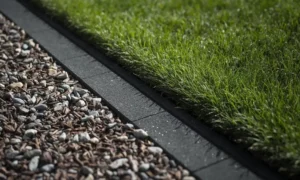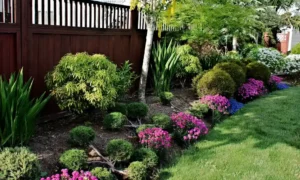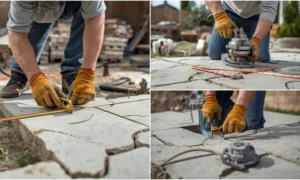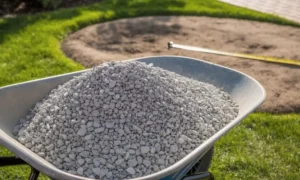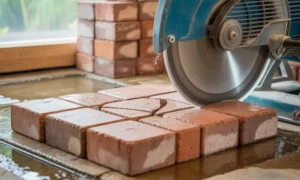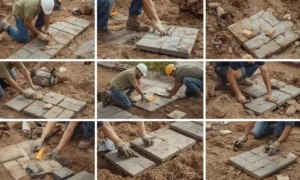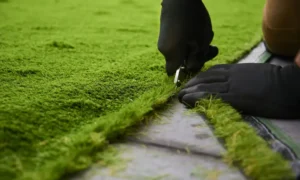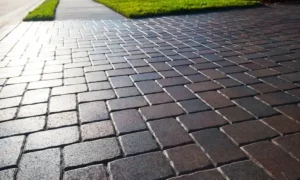What is landscaping in construction? It refers to the process of designing, building, and enhancing outdoor environments to align with the structure’s layout and aesthetics. Unlike simply adding greenery, landscaping construction involves strategic planning from the start of a project to ensure that the outdoor space functions as an extension of the built environment.
The construction of landscape features such as patios, pathways, retaining walls, irrigation systems, lighting, and plant installations is carefully coordinated to blend seamlessly with the architecture. When executed properly, landscaping in construction not only boosts visual appeal but also improves functionality and increases the overall value of the property.
Understanding Landscape Construction
Landscape construction is where creativity meets craftsmanship—it’s all about transforming outdoor spaces into beautiful, functional extensions of your home or business. Whether you’re starting fresh or updating an existing yard, this process blends structure and nature to bring your vision to life.
Hardscaping lays the foundation. Think patios, walkways, retaining walls, fences, and water features—these elements shape the layout, add style, and make your space more usable.
Softscaping brings the space to life. Trees, plants, flowers, and lush turf add color, movement, and a natural vibe. With mulch, topsoil, and nutrients, your landscape stays healthy and thriving.Together, hardscape and softscape create a seamless outdoor environment that’s not only beautiful but also tailored to your lifestyle.
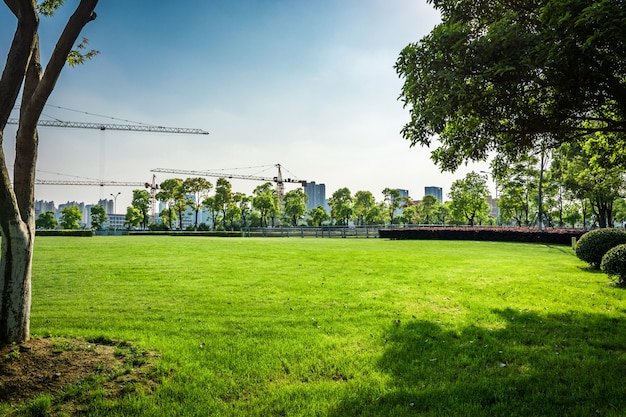
Why Does Landscaping Matter in Construction?
Improves Visual Appeal
Landscaping construction greatly enhances a property’s overall appearance. A well-planned landscape design creates an inviting environment for residents, employees, or visitors by adding charm and complementing the building’s architecture.
Increases the Value of Real Estate
A thoughtfully executed construction of landscape features often leads to higher property values. Buyers and tenants are more attracted to properties that offer attractive and functional outdoor areas, making landscaping a valuable investment.
Encourages Sustainability
Landscaping construction supports sustainable practices by integrating native plants, rain gardens, and efficient irrigation systems. These environmentally responsible methods help reduce the ecological footprint of construction projects.
Enhances Usability
Landscaping doesn’t just look good it also boosts functionality. Patios, pathways, sitting areas, and recreational spaces make outdoor environments more usable and enjoyable.
Handles Environmental Challenges
Proper landscaping construction addresses common environmental issues like wind protection, erosion control, and water drainage. These solutions help protect both the structure and its natural surroundings, ensuring long-term durability.
Key Elements of Landscaping in Construction
Landscaping in construction goes way beyond just planting a few trees. It’s about creating an outdoor space that’s functional, beautiful, and built to last. Here’s what makes it all come together:
Hardscaping – These are the solid features that shape your space: think walkways, patios, retaining walls, and water features. They give structure and style to your outdoor layout.
Softscaping – The living, breathing beauty! Trees, shrubs, flowers, and grass bring color, texture, and life to your landscape. It’s the part that grows and evolves with time.
Irrigation Systems – Smart watering systems keep your plants healthy without wasting water. It’s all about efficiency and sustainability.
Drainage Solutions – No one wants puddles or erosion. Proper drainage keeps your yard safe and your plants happy, even after a big Bay Area rain.
Outdoor Lighting – From path lights to accent lighting, the right illumination adds safety, depth, and a touch of nighttime magic.
How to Handle Construction Landscaping
When planning a new build, landscaping construction should be considered from the outset not treated as an afterthought. Integrating the construction of landscape features early ensures that your outdoor space complements the structure in both form and function. Here’s how to manage construction landscaping the right way:
Make a Plan First
Great landscapes don’t happen by accident. By including landscaping construction in your initial building plans, you ensure that every element—plant beds, walkways, lighting, and more feels intentional and cohesive. Early planning also leads to smoother execution and fewer costly surprises.
Join Forces with Experts
Work with architects and professional landscape designers who specialize in the construction of landscape elements. Their expertise ensures that your outdoor areas are not only visually appealing but also practical and long-lasting.
Consider Long-Term Upkeep
Choose plants and features that align with your or your client’s lifestyle. A beautifully designed yard only holds value if it’s manageable. Low-maintenance landscaping construction can save time, reduce stress, and minimize long-term costs.
Consider Sustainability When Designing
Sustainable landscaping is now a standard expectation. Use native plants, efficient irrigation systems, and eco-friendly materials to create a green space that’s both attractive and environmentally responsible.
Benefits of Landscaping in Construction
1. Enhances Property Aesthetics and Curb Appeal
Landscaping significantly improves the visual appeal of any construction project, creating a welcoming and polished look.
Blends Natural and Built Environments – Thoughtfully designed landscapes soften architectural structures and integrate them into the surrounding environment.
Customizable Design – Property owners can choose from various plant species, hardscape materials, and outdoor features to complement the overall design.
Seasonal Interest – A well-planned landscape provides year-round beauty with flowering plants, evergreens, and ornamental features.
2. Increases Property Value
A professionally landscaped property is more attractive to buyers, renters, and investors, leading to increased market value.
Boosts Home and Commercial Property Prices – Studies show that landscaping can increase property value by up to 20%.
Enhances Marketability – Properties with well-maintained landscapes sell faster and command higher prices than those without.
Long-Term Investment – Quality landscaping requires minimal upkeep compared to the value it adds over time.
3. Supports Environmental Sustainability
Sustainable landscaping practices help conserve resources, reduce waste, and promote eco-friendly construction methods.
Erosion Control – Proper grading, ground cover plants, and retaining walls prevent soil erosion and water runoff.
Water Conservation – Drought-tolerant plants, permeable pavers, and smart irrigation systems help minimize water usage.
Air and Noise Pollution Reduction – Trees and plants filter pollutants, improve air quality, and act as natural sound barriers in urban settings.
4. Improves Drainage and Stormwater Management
Poor drainage can cause flooding, soil erosion, and foundation damage—proper landscaping prevents these issues.
Grading and Sloping – Directs water flow away from structures, preventing water pooling and damage.
Permeable Surfaces – Materials like gravel, permeable pavers, and rain gardens absorb excess water, reducing stormwater runoff.
Retention Ponds and Bioswales – Collect and filter stormwater, helping to manage drainage naturally.
5. Enhances Outdoor Usability and Functionality
Landscaping extends living and working spaces beyond interior structures, making outdoor areas more enjoyable and practical.
Outdoor Living Spaces – Patios, decks, and fire pits create inviting spaces for relaxation and entertainment.
Functional Commercial Spaces – Landscaped courtyards, walkways, and seating areas enhance employee and visitor experiences.
Shade and Cooling Effects – Proper tree placement reduces heat buildup, making outdoor areas more comfortable and energy-efficient.
6. Encourages Biodiversity and Wildlife Habitat
Thoughtful landscaping supports local ecosystems by providing shelter and food for beneficial wildlife.
Pollinator Gardens – Native flowers attract bees, butterflies, and other pollinators essential for plant growth.
Bird-Friendly Landscaping – Trees and shrubs offer nesting sites and food sources for birds.
Natural Green Spaces – Reduce the need for artificial landscaping elements while promoting biodiversity.
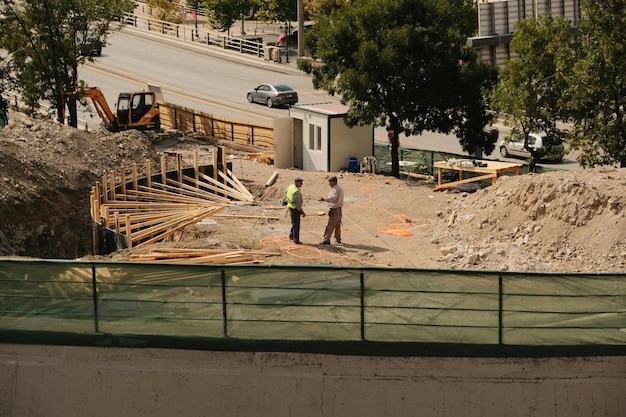
Why Choose Lakota Design Group for Your Landscape Construction Needs?
Every property owner wants the best for their outdoor space—with minimal stress along the way. When you choose Lakota Design Group, you get a trusted Bay Area partner who prioritizes your vision from start to finish. We’re committed to quality, communication, and long-term success.
In addition to expert Bay area landscape construction, we offer ongoing landscape maintenance services to keep your property thriving year-round. Plus, our continued care can help extend your warranty beyond the standard term protecting your investment and ensuring lasting beauty.
Landscape construction is no small task. That’s why it’s vital to partner with a top-rated, experienced team like Lakota Design Group. With decades of award-winning work across residential homes, commercial spaces, and specialty landscapes, we help you avoid costly mistakes and bring your outdoor dreams to life—flawlessly.
Conclusion
Understanding what landscaping in construction entails goes beyond simply planting a few trees and shrubs. It’s about creating harmonious, functional, and sustainable outdoor spaces that enhance the overall value of a project. From boosting curb appeal to addressing environmental challenges, landscaping plays a vital role in construction.So, the next time you’re involved in a building project, remember the importance of landscaping. It’s not just about the structure—it’s about the environment that surrounds it, too. A thoughtfully designed landscape can transform the perception of any project, making it more inviting, eco-friendly, and visually appealing.
That’s why choosing Lakota Design Group ensures your outdoor space is designed with expertise, sustainability, and long-term value in mind. We specialize in creating landscapes that integrate green spaces, efficient drainage systems, and eco-friendly materials, ensuring that your property is both beautiful and highly functional. With our professional touch, your construction project will stand out, making a lasting impact on both the human experience and the environment.
FAQS
What is landscaping in construction?
Landscaping in construction involves designing and implementing outdoor environments to enhance the aesthetic, functional, and sustainable aspects of a building project.
Why does landscaping matter in construction?
Landscaping improves property value, promotes sustainability, manages environmental challenges, and creates visually appealing and functional outdoor spaces.
How does landscaping in construction differ from regular landscaping?
Construction landscaping integrates outdoor design into the overall development plan, ensuring harmony between the building and its surroundings.
What are the key components of landscaping in construction?
Key components include hardscaping (paths, walls), softscaping (plants, grass), irrigation systems, drainage solutions, and outdoor lighting.
How does landscaping in construction promote sustainability?
Sustainability is achieved through eco-friendly practices like using native plants, efficient irrigation, and systems to reduce soil erosion and water waste.




